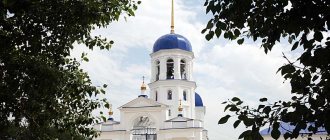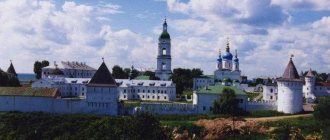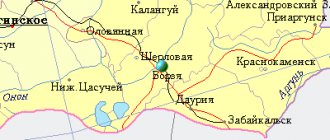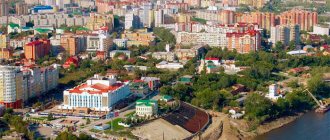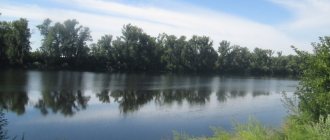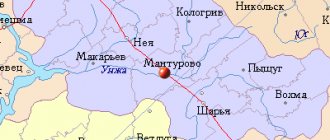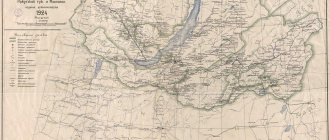The Ivdel River flows in the north of the Sverdlovsk region. It is known for its picturesque rocky shores and pointed single rocks. Some reach a height of more than a hundred meters. The entire surrounding space is occupied by vast wild taiga. You will hardly find human habitation here. In these places there is the Dyatlov Pass - one of the most mysterious places in Russia.
Ivdel River
Among the boundless taiga
The sources of the Ivdel River are located on the northern slope of Mount Yanygtump, which has a height of just over a thousand meters above sea level. The river meanders through the taiga and, 116 kilometers from the place of birth, flows into the Lozva River. Ivdel has 13 tributaries. Administratively, it is “assigned” to the Sverdlovsk region, but flows very close to the borders of the Komi Republic and the Khanty-Mansiysk Autonomous Okrug. This is a typical Ural north.
River embankment in the city of Ivdel
You don't have to go rafting to get to the picturesque rocks. From the city of Ivdel, it is enough to follow the path along the left bank of the river. The group of rocks is called the Ivdel stone. Columnar ledges up to 70 meters high stretch for two kilometers, forming an impregnable rocky cliff hanging over the water. There are more beautiful ledges further upstream, but they can only be reached by water.
The Great Yurtishchenskaya Cave, located near the coastline, is considered a natural attraction. Its length reaches 930 meters. In the vicinity of the city of Ivdel there are several more caves, including Shaitanskaya and Mamontova. Archaeologists have discovered ancient Mansi sanctuaries in them. A waterway passed through these places to the Tobol River, which was used back in the Middle Ages.
Until 2022, Ivdel was ideal for fishing. Grayling, taimen, and char were caught here. Fishermen's trophies were often tugun and nelma. There were plenty of perches, ides and pikes. However, after toxic substances from one of the mining enterprises entered the river, fish in the vicinity of the city of Ivdel almost disappeared.
The river is not full of water, so it is better to raft on it immediately after the flood, or after heavy summer rains. Usually rafting starts in the Second Dam tract - this is the name of the pond, which was previously used as a reservoir during timber rafting. There may be sandbanks, fallen trees and small rocks along the way. The period of white nights, which lasts from mid-May to mid-June, is very beautiful in these places.
This is what northern white nights look like
The climate here is not sweet. Winter begins in mid-October and ends in mid-April. The average February temperature is minus 22 degrees, but forty-degree frosts are not uncommon. Summer is short and cool with an average July temperature of +17 degrees. Winter is snowy. The most rain falls in July and August.
Administrative and municipal status
As part of the structure of administrative units, this is together with the working settlement of Pelym and thirty-three rural areas, included as the Town of Ivdel
[1] - administrative unit with a status equal to that of districts.[9]
As a municipal entity, Ivdel and twenty-nine rural settlements are included in the Ivdel urban district
.[4] The urban-type settlement of Pelym, along with four other rural settlements, is included separately as the Pelym urban district.[4]
From gold mine to camps
On the river stands the city of Ivdel with a population of about 15 thousand people. The first wooden fortress appeared here back in 1589. Then it was called Lozvinsky town. This was the first Russian settlement on the territory of what is now the Sverdlovsk region. At the beginning of the 19th century, gold was found here. Merchant Vsevolod Vsevolozhsky founded a gold mine and processing plant. Then the settlement was renamed Shapshu.
In some places Ivdel is deep and quite suitable for rafting
After the death of the owner in 1849, Vsevolozhsky’s inheritance went to his son Nikita, and the mine began to be called Nikito-Ivdelsky, after the name of the river. During the same period, the Nikitin Church was founded in honor of the Great Martyr Nikita. Then the village received rural status. It was renamed Ivdel in 1924, and awarded city status in 1943.
At the end of the 30s of the last century, a tragic period began in the history of the city - the NKVD founded IvdelLAG in its vicinity. The prisoners felled timber, mined ore, and built a railroad. All of these were “enemies of the people.” In the 50s, there were 47 camps, which housed 22 thousand prisoners. Then their number began to decrease. Only criminals remained. There are currently three sensitive facilities in the city. Another number have recently been disbanded. Including, “Black Golden Eagle” - a colony for life prisoners.
Ivdel Local Lore Museum
There are few attractions in Ivdel. There is a local history museum. There are four churches: the old Nikitskaya and new ones - Blagoveshchenskaya and St. Andrew's. In 2008, a church was built in honor of the New Martyrs and Confessors of Russia. A beautiful embankment stretches along the river. A cedar grove with ancient Mansi burials is considered a natural monument. The grove is located on the southwestern outskirts and has more than 300 trees. Their age is about 200 years.
Temple in honor of the Annunciation of the Blessed Virgin Mary on the banks of Ivdel
The surrounding area of the Ivdel River is a real natural storehouse. What's missing here! Gold, coal, manganese, iron and copper ore, bauxite are raw materials for the production of aluminum. There are 16 specially protected natural sites in the area, including the Bolshaya Umpiya hydrological reserve, virgin forests in the Vizhay forestry, and the Ivdel Rocks. Along the banks there are limestone outcrops in which ancient fossils can be found.
Used materials
- “From the history of Ivdel”, regional network of urban sites of the Sverdlovsk region, November 10, 2009:
- Article from the people's encyclopedia of cities and regions of Russia My City
: - “Ural”, private website about Yekaterinburg:
[1] Nadezhda Mikhailovna Polunina, “Chronicle of the founding of Siberian forts in the 16th-17th centuries,” local history website by A. Z. Kozina Pribaikalsky district of the Republic of Buryatia
,
[2] “From the history of Ivdel”, regional network of urban sites of the Sverdlovsk region, November 10, 2009,
Mountain of the Dead
Despite the remoteness from civilization, these places are in great demand among lovers of hiking and skiing. The reason for this is the Dyatlov Pass. It is located on a mountain that the Mansi call “Kholatchakhl”. Translated into Russian it means “Mountain of the Dead.” She became famous after the mysterious death of a group of tourists. Before this incident, the mountain was nameless and was designated on the map as height “1079”.
In February 1959, a group of ten experienced tourists went on a hike of the third degree of difficulty. The leader of the group was Igor Dyatlov. It was not possible to climb to the top before dark, and the tourists set up a tent on a gentle slope. After dinner we began to settle down for the night. And then something terrible happened!
According to investigators, there was panic. The tourists cut the tent with knives and, naked, without shoes, rushed to run down the slope. The tracks indicated that people were trying to scatter to the sides, but it was as if some force was driving them together. The tracks disappeared in the forest, and soon the search team discovered several corpses of tourists under the snow.
Monument to those who died for Soviet power on the river bank
After some time, the remaining corpses were found near the stream. Their skin had an unusual dark brown color. Many had terrible internal injuries - broken ribs, broken skulls, severely damaged internal organs. And at the same time, the skin is almost not affected! In the vicinity of the camp, no traces of the presence of strangers or a natural disaster were found. The investigation has reached a dead end.
More than 50 years have passed, but the strange death of the children remains a mystery. There are many versions of what happened. According to one of them, the tent was covered by an avalanche. However, searchers found her on the surface of the snow. The streamers were not torn down, the sticks stuck in the snow were not knocked down. The incident was also explained by the phenomenon of a “perfect storm” - a natural phenomenon that generates ultrasound, causing panic. It was assumed that tourists were poisoned with methyl alcohol, attacked by wild animals, and exposed to ball lightning.
There were also purely “man-made” versions. The Dyatlovites were allegedly killed by escaped prisoners. Or they suffered at the hands of the Mansi, as tourists encroached on the sacred mountain. They assumed a quarrel between the tourists themselves. Or for some reason the group was attacked by IvdelLAG guards. However, the investigation found all this unfounded.
The tourist route to the Dyatlov Pass passes through Ivdel
Among the more plausible hypotheses, conspiracy theories should be noted. Tourists could get into the area of secret military tests. This is evidenced by the testimony of eyewitnesses who saw luminous objects over the mountain that day. There may have been a rocket or vacuum bomb explosion. In this case, tourists suffered from the blast wave or were removed as unwitting witnesses. The clue for the “military” version could be a strange railway line near the village of Polunochnoye, which runs into the mountain. In addition, a local hunter allegedly found rocket debris two years after the tragedy.
Perhaps a rocket filled with phosgene depressurized over Mount Kholatchakhl. In this case, suffocation occurs only a few hours after poisoning. All this time the person does not notice anything except a sweetish taste in the mouth. When the tourists began to choke, they cut the tent in panic and ran away. Of course, they thought that the source of the suffocation was in the tent. The survivors were killed as witnesses. Then the military put pressure on the investigation to cover up the incident. How else can you explain that the case was classified?
The mysterious incident has aroused great interest for many years. Two fiction books, a dozen and a half documentaries, several television shows and the feature horror film “The Mystery of the Dyatlov Pass” are dedicated to the tragedy. Now these places are regularly visited by tourist groups. Some come in search of a solution to the mystery, others to test themselves, and others to honor the memory of the dead. In 1963, a memorial plaque was installed on the stone outcrop. And in 2012, three plates were mounted depicting the pages of the Ural Pathfinder magazine with an article about the Dyatlov group.
Adventures from our tourist club in this direction
12.03 – 19.03 |
8 days Ski trip to Dyatlov Pass
Ski trip – To the Manpupuner plateau – Ural
Hiking – Through the Dyatlov Pass to the Manpupuner Plateau
Hiking – To the Dyatlov Pass
Climate
Ivdel has a subarctic climate (Köppen climate classification DFC
), with very cold winters and warm summers. Precipitation is moderate, in summer it is slightly higher than at other times of the year.
| Climate data for Ivdel | |||||||||||||
| Month | Jan | Feb | Mar | Apr | May | Jun | Jul | Aug | Sep | October | But I | December | Year |
| Daily average °C (°F) | −19.8 (−3.6) | −16.6 (2.1) | −6.7 (19.9) | 1.0 (33.8) | 7.5 (45.5) | 14.1 (57.4) | 17.4 (63.3) | 13.5 (56.3) | 7.6 (45.7) | −0.7 (30.7) | −9.2 (15.4) | −15.9 (3.4) | −0.7 (30.8) |
| Average precipitation mm (inches) | 24.8 (0.98) | 16.8 (0.66) | 18.8 (0.74) | 32.8 (1.29) | 47.5 (1.87) | 60.3 (2.37) | 89.1 (3.51) | 75.7 (2.98) | 53.5 (2.11) | 41.6 (1.64) | 30.2 (1.19) | 26.1 (1.03) | 517.2 (20.37) |
| Average number of days with precipitation (≥ 1.0 mm) | 7.5 | 4.9 | 4.5 | 6.7 | 7.7 | 9.3 | 10.1 | 10.6 | 9.5 | 9.0 | 7.4 | 7.2 | 94.4 |
| Average monthly sunshine | 54 | 99 | 161 | 188 | 247 | 284 | 283 | 212 | 132 | 89 | 56 | 25 | 1,830 |
| Source: NOAA (1961–1990).[10] | |||||||||||||

